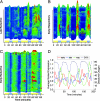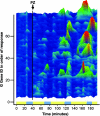A rapid genome-scale response of the transcriptional oscillator to perturbation reveals a period-doubling path to phenotypic change
- PMID: 17043222
- PMCID: PMC1613231
- DOI: 10.1073/pnas.0604860103
A rapid genome-scale response of the transcriptional oscillator to perturbation reveals a period-doubling path to phenotypic change
Abstract
Perturbation of the gated-synchrony system in yeast with phenelzine, an antidepressant drug used in the treatment of affective disorders in humans, leads to a rapid lengthening in the period of the genome-wide transcriptional oscillation. The effect is a concerted, genome-scale change in expression that is first seen in genes maximally expressed in the late-reductive phase of the cycle, doubling the length of the reductive phase within two cycles after treatment. Clustering of genes based on their temporal patterns of expression yielded just three super clusters whose trajectories through time could then be mapped into a simple 3D figure. In contrast to transcripts in the late-reductive phase, most transcripts do not show transients in expression relative to others in their temporal cluster but change their period in a concerted fashion. Mapping the trajectories of the transcripts into low-dimensional surfaces that can be represented by simple systems of differential equations provides a readily testable model of the dynamic architecture of phenotype. In this system, period doubling may be a preferred pathway for phenotypic change. As a practical matter, low-amplitude, genome-wide oscillations, a ubiquitous but often unrecognized attribute of phenotype, could be a source of seemingly intractable biological noise in microarray studies.
Conflict of interest statement
The authors declare no conflict of interest.
Figures





Comment in
-
Discovery of principles of nature from mathematical modeling of DNA microarray data.Proc Natl Acad Sci U S A. 2006 Oct 31;103(44):16063-4. doi: 10.1073/pnas.0607650103. Epub 2006 Oct 23. Proc Natl Acad Sci U S A. 2006. PMID: 17060616 Free PMC article. No abstract available.
References
MeSH terms
Substances
LinkOut - more resources
Full Text Sources
Molecular Biology Databases
Research Materials

